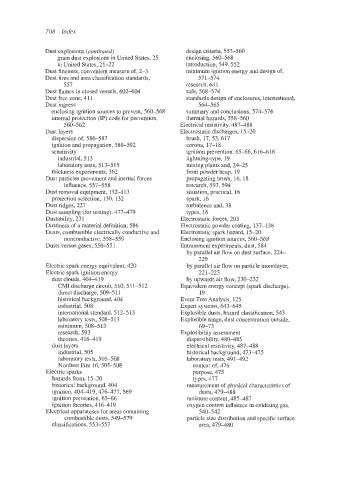Page 755 - Dust Explosions in the Process Industries
P. 755
708 Index
Dust explosions (continued) design criteria, 557-560
grain dust explosions in United States, 25 enclosing, 560-568
in United States, 21-22 introduction, 549-552
Dust fineness, convenient measure of, 2-3 minimum ignition energy and design of,
Dust fires and area classificationstandards, 571-574
557 research, 641
Dust flames in closed vessels, 602-604 safe, 568-574
Dust free zone, 411 standards design of enclosures, international,
Dust ingress 564-565
enclosing ignition sources to prevent, 560-568 summary and conclusions, 574-576
internal protection (IP) code for prevention, thermal hazards, 558-560
560-562 Electrical resistivity,487488
Dust layers Electrostatic discharges, 15-20
dispersion of, 586-587 brush, 17,53,617
ignition and propagation, 589-592 corona, 17-18
sensitivity ignition prevention, 65-66, 616-618
industrial, 513 lightning-type, 19
laboratory tests, 513-5 15 mixing plants and,24-25
thickness experiments, 362 from powder heap, 19
Dust particles movement and inertial forces propagating brush, 16, 18
influence, 557-55 8 research, 593,594
Dust removal equipment, 112-113 situation, practical, 16
protection selection, 130, 132 spark, 16
Dust ridges, 227 turbulence and, 38
Dust sampling (for testing), 477479 types, 16
Dustability, 231 Electrostatic forces, 203
Dustiness of a material definition, 586 Electrostatic powder coating, 137-138
Dusts, combustible electrically conductive and Electrostatic spark hazard, 15-20
nonconductive, 558-559 Enclosing ignition sources, 560-568
Dusts versus gases, 550-551 Entrainment experiments,dust, 584
by parallel air flow on dust surface, 224-
229
Electric spark energy equivalent, 420 by parallel air flow on particle monolayer,
Electric spark ignition energy 22 1-223
dust clouds, 404419 by upwards air flow, 230-232
CMI discharge circuit, 510,511-5 12 Equivalent energy concept (spark discharge),
direct discharge, 509-511 19
historical background, 404 Event Tree Analysis, 125
industrial, 508 Expert systems, 643-645
international standard, 512-5 13 Explosible dusts, hazard classification,543
laboratory tests, 508-513 Explosible range, dust concentration outside,
minimum, 508-5 13 69-73
research, 593 Explosibility assessment
theories, 416419 dispersibility,480-485
dust layers electrical resistivity,487488
industrial, 505 historical background, 473475
laboratory tests, 505-508 laboratory tests, 491492
Nordtest Fire 16,505-508 context of, 476
Electric sparks purpose, 475
hazards from, 15-20 types, 477
historical background, 404 measurement of physical characteristicsof
ignition, 404419,476477,569 dusts, 479488
ignition prevention, 65-66 moisture content, 485487
ignition theories, 416419 oxygen content influencein oxidizing gas,
Electrical apparatusesfor areas containing 540-542
combustible dusts, 549-579 particle size distribution and specific surface
classifications,553-557 area, 479480

